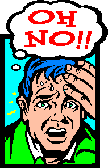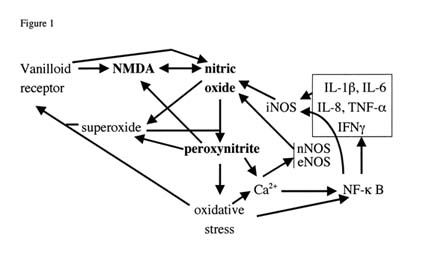"No! Oh No! a New Cycle!"
A few weeks ago I had to take a little break from my experiment for our weekly Research Experience for Undergraduates seminar. Feeling casual and not expecting much, I left my tissues incubating and strolled on down to the mechanical engineering building where the seminars are held. I had no idea that I was about to embark upon a starting new theory, possibly even a new disease paradigm!
There are currently many known causes of disease including infection, genetic disorders, cancer, autoimmune diseases, and poisoning. Still, some illnesses remain unexplained by known etiological mechanisms. Sicknesses such as chronic fatigue syndrome (CFS), multiple chemical sensitivity (MCS), fibromyalgia, and posttraumatic stress disorder (PTSD) appear not to fall into any known category and remain mysteries to the medical community. Their odd set of symptoms and the variety of cases are a puzzle what have continually frustrated doctors, researchers, patients and their families. They do have a few things in common though, besides the fact that they remain unexplained. Many patients experience a "trigger" which initiates their illness, commonly a severe emotional stressor, injury, or infection. They are all chronic illnesses with multiple symptoms. There is also a great deal of overlap in diagnosis of these disorders as they share many qualities, almost all involving some form of fatigue, hyperalgesia (excessive pain), depression, or anxiety. With so much in common, could there be a common cause for these illnesses? Dr. Martin Pall of Washington State University says, "yes!"
At the seminar Dr. Pall exposed his fascinating new theory on the possible cause of these disorders (and maybe others). He proposes a vicious cellular cycle that, once triggered, may continue indefinitely unless measures are taken to moderate it.
Inherent in all our cells is the ability to produce nitric oxide from the action of nitric oxide synthase enzymes. Nitric oxide (NO) is a natural part of the environment of the body and plays important roles as a neurotransmitter and cell signaling molecule.
 Unfortunately, when stressed, these nitric oxide synthase enzymes can begin to produce excess NO and its oxidant product peroxynitrite (ONOO) leading to a chronic, cyclic increase in the quantities of both chemical products. The up-regulation of nitric oxide and peroxynitrite make up part of the vicious cycle Dr. Pall calls the "No!, Oh no!" cycle after the convenient way the chemical abbreviations for nitric oxide and peroxynitrite (NO/ONOO) can be read.
Unfortunately, when stressed, these nitric oxide synthase enzymes can begin to produce excess NO and its oxidant product peroxynitrite (ONOO) leading to a chronic, cyclic increase in the quantities of both chemical products. The up-regulation of nitric oxide and peroxynitrite make up part of the vicious cycle Dr. Pall calls the "No!, Oh no!" cycle after the convenient way the chemical abbreviations for nitric oxide and peroxynitrite (NO/ONOO) can be read.Aside from NO and ONOO, there are multiple cellular mechanisms involved in the NO/ONOO cycle. Thus far, Dr. Pall suggests 22 mechanisms in the cycle, which, when diagramed, appear more like a mass of arrows than a circle. Among the things feeding from and feeding into the cycle are transcription factors for production of nitric oxide synthase enzymes, inflammatory cytokines, intracellular calcium ion levels, and activity of the NMDA and Vanilloid receptors. For each disorder, human or animal models have been found to have an excess of some or all of the elements of the cycle. Dr. Pall cites a convincing number of studies for each illness, all pointing to one or more of the cellular pathways involved. Below is a figure he sent me, depicting the many cellular pathways of the NO/ONOO cycle:

All together the NO/ONOO cycle has dire effects on the health of cells. Primarily, peroxynitrite is detrimental to the function of mitochondria, the cell’s energy production source. When these important energy organelles are damaged, fatigue, a common symptom of the "unexplained" illnesses, is inevitable. The cycle also results in oxidative damage to cells and the tissue of the affected area is harmed. Another result of the cycle has to do with stimulation of certain neural pathways. Nitric oxide stimulates the nociceptors that initiate the perception of pain and this may explain the common hyperalgesia symptom of these illnesses. NMDA receptors also respond to NO and ONOO as well as contribute to their up-regulation. NMDA receptors are common in the amygdale where their excessive firing can create anxiety.
Now, this all sounds quite alarming, but before you go tossing all of your "miracle blue pills for the middle aged man," or chastising Stephan and John for their work in synthesis of NMDA agonists, remember that nitric oxide does play some important roles in the body too. So if this cycle is possible in us all and can be initiated by such seemingly common stressors like infection and injury, why do some people develop chronic illnesses while others do not? One factor may be the severity of the stressor. More potent, long lasting infections may increase the levels of inflammatory cytokines more than others and therefore better contribute to the cycle. There may be a genetic link that makes some people more susceptible as well. Hormone levels may also play a role. Diet is an especially important factor to look at though as it may have a healing influence on the cycle. Antioxidants will lessen the effects of the NO/ONOO. Magnesium is an antioxidant of key interest as it also lowers NMDA receptor activity. The U.S. is known for some magnesium deficiency, so it's no surprise that the incidence of NO/ONOO cases may be high here.
For each symptom of these puzzling disorders, a possible cause can be traced back to some element of the NO/ONOO cycle. If true, the theory provides a basis for new research into possible cures. I hope to write more on this topic and the fascinating cellular mechanisms involved in future "Feature Wednesday" articles. Dr. Pall has been kind enough to allow me to review a draft of his new book, Explaining "Unexplained Illnesses": Disease Paradigm for Chronic Fatigue Syndrome, Multiple Chemical Sensitivity, Fribromyalgia, Posttraumatic Stress Disorder, Gulf War Syndrome, and Others and I still have a long way to go before it's finished. Although the theory has not yet been accepted I'm excited to be one of the first to read about (and I hope you are now too!). As D. Pall writes in his book,
"At worst, it gives us a testable framework for further 'hypothesis driven experimentation'...At best, it provides the great beam of light to illuminate our way."
Sources: Dr. Martin Pall. Explaining "Unexplained Illnesses": Disease Paradigm for Chronic Fatigue Syndrome, Multiple Chemical Sensitivity, Fribromyalgia, Posttraumatic Stress Disorder, Gulf War Syndrome, and Others. Slated for publication in May 2007
http://molecular.biosciences.wsu.edu/faculty/pall.html


3 Comments:
Kim -- thanks for this post. I'm eager to read your review of Dr. Pall's book.
I'd be especially interested to find out two things:
(1) Whether his hypothesis could explain why many people with fibromyalgia/chronic fatigue syndrome have worsening of symptoms after surgery that involves general anesthesia and (2) Whether his hypothesis could explain why the symptoms of many (but not all) patients with fibromyalgia/chronic fatigue syndrome gradually get better (after an initial worsening)on Dr. R. Paul St. Amand's guaifenesin protocol, which requires the avoidance of strong salicylates taken by mouth (such as herbal supplements and mint/menthol toothpastes) and all topical salicylates (such as aloe, plant oils, and salicylate-based sunscreens). I haven't seen his hypothesis explained to my satisfaction, but the explanations of his detractors don't account for the initial worsening of symptoms or why so many people have improved on the protocol.
Curious,
Susan
By Anonymous, at 10:24 AM
Anonymous, at 10:24 AM
the best machine of the universe do not stop nitric oxide production altought it damages itself .. come on .. there must be a reason body keeps on making this nitric oxide , yes like lyme or c.pneumonia or whatever ..
By Anonymous, at 12:45 PM
Anonymous, at 12:45 PM
Anonymous- Nitric oxide is used by the phagocytic cells of the immune system to generate oxidative reagents which are used to destroy microbes. Dr. Pall goes over this and other functions of NO in his book. It seems to me that he does not intend to rid the body of nitric oxide synthesis, but rather to set the cycle back at a natural rate when it has gotten out of hand.
By Kit, at 12:55 PM
Kit, at 12:55 PM
Post a Comment
<< Home